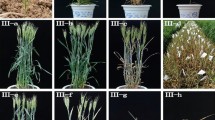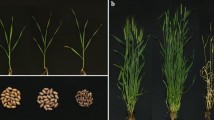Abstract
Segregation distortion of molecular markers is closely related to hybrid incompatibility in progeny from intraspecific crosses. Recent reports in higher plants have demonstrated that hybrid sterility results in segregation distortion at the causal gene regions in progeny of intraspecific crosses. Ne1 and Ne2 complementary loci are known to control hybrid necrosis in intraspecific crosses of common wheat cultivars. Here, we examine the effect of a weak necrosis allele Ne1 w on the segregation ratio of molecular markers in recombinant inbred lines (RILs) of common wheat. Some RILs showed accelerated cell death in the leaves at the heading stage due to the epistatic interaction between two quantitative trait loci (QTL) on chromosomes 5B and 2B. Chromosomal localization of these QTL corresponding to Ne1 w and Ne2 showed distorted segregation ratios of assigned markers having oppositely biased direction. Although the Ne1 w and Ne2 interaction had no obvious effect on seed fertility, Ne1 w reduced completion of grain development under the Ne2-homozygous background. This reduction might be one of causes that induces segregation distortion in the 5B and 2B chromosomal regions of RILs. The present study demonstrated that weak hybrid necrosis has limited phenotypic effects; it causes segregation distortion in progeny from intraspecific crosses.



Similar content being viewed by others
References
Alcázar R, García AV, Parker JE, Reymond M (2009) Incremental steps toward incompatibility revealed by Arabidopsis epistatic interactions modulating salicylic acid pathway activation. Proc Natl Acad Sci USA 106:334–339
Alcázar R, García AV, Kronholm I, de Meaux J, Koornneef M, Parker JE, Reymond M (2010) Natural variation at Strubbelig Receptor Kinase 3 derives immune-triggered incompatibilities between Arabidopsis thaliana accessions. Nat Genet 42:1135–1139
Bikard D, Patel D, Le Metté C, Giorgi V, Camilleri C, Bennett MJ, Loudet O (2009) Divergent evolution of duplicate genes leads to genetic incompatibilities within A. thaliana. Science 323:623–626
Bomblies K, Weigel D (2007) Hybrid necrosis: autoimmunity as a potential gene-flow barrier in plant species. Nat Rev Genet 8:382–393
Bomblies K, Lempe J, Epple P, Warthmann N, Lanz C, Dangl JL, Weigel D (2007) Autoimmune response as a mechanism for Dobzhansky–Muller-type incompatibility syndrome in plants. PLoS Biol 5:e236
Chu CG, Faris JD, Friesen TL, Xu SS (2006) Molecular mapping of hybrid necrosis genes Ne1 and Ne2 in hexaploid wheat using microsatellite markers. Theor Appl Genet 112:1374–1381
Dalal M, Khanna-Chopra R (2001) Differential response of antioxidant enzymes in leaves of necrotic wheat hybrids and their parents. Physiol Plant 111:297–304
Dhaliwal HS, Sharma SK, Randhawa AS (1986) How to overcome hybrid necrosis in wheat? Wheat Inf Serv 61:27–28
Hermsen JGT (1963a) The genetic basis of hybrid necrosis in wheat. Genetica 33:245–287
Hermsen JGT (1963b) Hybrid necrosis as a problem for the wheat breeder. Euphytica 12:1–16
Hermsen JGT (1963c) Sources and distribution of the complementary genes for hybrid necrosis in wheat. Euphytica 12:147–160
Jeuken MJW, Zhang NW, McHale LK, Pelgrom K, den Boer E, Lindhout P, Michelmore RW, Visser RGF, Niks RE (2009) Rin4 causes hybrid necrosis and race-specific resistance in an interspecific lettuce hybrid. Plant Cell 21:3368–3378
Khanna-Chopra R, Dalal M, Kumar PG, Laloraya M (1998) A genetic system involving superoxide causes F1 necrosis in wheat (Triticum aestivum L.). Biochem Biophys Res Commun 248:712–715
Kobayashi F, Takumi S, Handa H (2010) Identification of quantitative trait loci for ABA responsiveness at seedling stage associated with ABA-regulated gene expression in common wheat. Theor Appl Genet 121:629–641
Kosambi DD (1944) The estimation of map distance from recombination values. Ann Eugen 12:172–175
Kubo T, Yoshimura A, Kurata N (2011) Hybrid male sterility in rice is due to epistatic interactions with a pollen killer locus. Genetics 189:1083–1092
Lander ES, Green P, Abrahamson J (1987) MAPMAKER: an interactive computer package for constructing primary genetic linkage maps of experimental and natural populations. Genomics 1:174–181
Long Y, Zhao L, Niu B, Su J, Wu H, Chen Y, Zhang Q, Guo J, Zhuang C, Mei M, Xia J, Wang L, Wu H, Liu YG (2008) Hybrid male sterility in rice controlled by interaction between divergent alleles of two adjacent genes. Proc Natl Acad Sci USA 105:18871–18876
Mizuta Y, Harushima Y, Kurata N (2010) Rice pollen hybrid incompatibility caused by reciprocal gene loss of duplicated genes. Proc Natl Acad Sci USA 107:20417–20422
Presgraves DC (2010) The molecular evolutionary basis of species formation. Nat Rev Genet 11:175–180
Pukhalskiy VA, Martynov SP, Dobrotvorskaya TV (2000) Analysis of geographical and breeding-related distribution of hybrid necrosis genes in bread wheat (Triticum aestivum L.). Euphytica 114:233–240
Pukhalskiy VA, Udachin RA, Bilinskaya EN (2009) Hybrid necrosis genes in aboriginal wheats of Middle Asia in the light of the problem of the primary centers of biodiversity of the Triticum L. genus. Euphytica 165:533–543
Rieseberg LH, Willis JH (2007) Plant speciation. Science 317:910–914
Sears ER, Loegering WQ (1961) A pollen-killing gene in wheat. Genetics 46:897
Sugie A, Murai K, Takumi S (2007) Alteration of respiration capacity and transcript accumulation levels of alternative oxidase genes in necrosis lines of common wheat. Genes Genet Syst 82:231–239
Tsunewaki K (1960) Monosomic and conventional analyses in common wheat. III. Lethality. Jpn J Genet 35:71–75
Tsunewaki K (1970) Necrosis and chlorosis genes in common wheat and its ancestral species. Seiken Ziho 22:67–75
Tsunewaki K (1992) Aneuploid analyses of hybrid necrosis and hybrid chlorosis in tetraploid wheats using the D genome chromosome substitution lines of durum wheat. Genome 35:594–601
Tsunewaki K, Koba T (1979) Production and genetic characterization of the co-isogenic lines of a common wheat Triticum aestivum cv. S-615 for ten major genes. Euphytica 28:579–592
Veisz O, Sutka J (1990) Frost resistance studies with wheat in natural and artificial conditions. In: Panayotov I, Pavlova S (eds) Proceedings of the international symposium on cereal adaptation to low temperature stress. Albena, Bulgaria, pp 12–17
Wang S, Basten CJ, Zeng ZB (2011) Windows QTL cartographer 2.5. Department of Statics, North Carolina State University, Raleigh, NC. http://statgen.ncsu.edu/qtlcart/WQTLCart.htm
Yamagata Y, Yamamot E, Aya K, Win KT, Doi K, Ito T, Kanamori H, Wu J, Matsumoto T, Matsuoka M, Ashikari M, Yoshimura A (2010) Mitochondrial gene in the nuclear genome induces reproductive barrier in rice. Proc Natl Acad Sci USA 107:1494–1499
Yang J, Zhao X, Cheng K, Du H, Ouyang Y, Chen J, Qiu S, Huang J, Jiang Y, Jiang L, Wang J, Zu C, Li X, Xhang Q (2012) A killer-protector system regulates both hybrid sterility and segregation distortion. Science 337:1336–1340
Acknowledgments
The authors thank emeritus professor Dr. Koichiro Tsunewaki for helpful discussion and supplying seeds of cultivars Ne1-S615 and Ne2-S615. This work was supported by Grants-in-Aid for Scientific Research (B) No. 21380005 and No. 25292008 to ST from the Ministry of Education, Culture, Sports, Science and Technology (MEXT) of Japan.
Author information
Authors and Affiliations
Corresponding author
Rights and permissions
About this article
Cite this article
Takumi, S., Motomura, Y., Iehisa, J.C.M. et al. Segregation distortion caused by weak hybrid necrosis in recombinant inbred lines of common wheat. Genetica 141, 463–470 (2013). https://doi.org/10.1007/s10709-013-9745-2
Received:
Accepted:
Published:
Issue Date:
DOI: https://doi.org/10.1007/s10709-013-9745-2




